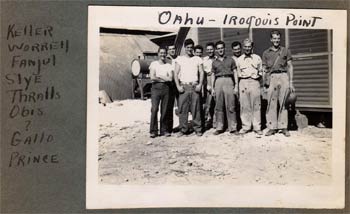Jumpin Antietam
11 July 2008
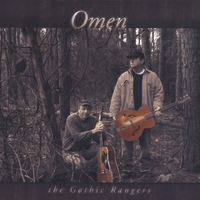
Tim Buck and Robin Willhite are the musicians of The Gothic Rangers. Tim dropped a note to let me know about their new CD Omen. Among the collection of folk-rocky songs is a strangely upbeat Antietam. Can’t be all that many songs out there with that title …
The pace and feel are “jaunty”, as Tim puts it, but the story sure aint.
Mine eyes saw fervor at Antietam
Mad dog murder at Antietam
Grapeshot workin' at Antietam
Red hot fervor at Antietam
Red hot fervor at Antietam
Do check out the Gothic Rangers. You can hear Antietam and the other songs from their new work on the band’s MySpace page. CD Baby has ’em, and says
These songs about the Civil War, love’s mystery, unquiet spirits, and dark forebodings are infused with rockin’ energy and lyrical passion.
Unique sound, and well worth a listen. Mad dog murder indeed.
Welcome Steve’s stompin’ blog
11 June 2008
Battlefield tourer Steven Mynes has begun a new blog at CW Battles and Battlefields to share his adventures. His first post is of particular interest, being a presentation of the action of Fire on the Mountain: last weekend’s artillery reenactment at Fox’s Gap on South Mountain. A nice collection of action photos is included, with more promised.
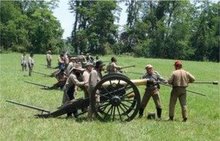
The Battery (S. Mynes, from his blog)
Steve also shows fine form in the selection of his first Site of the Month feature …
Welcome Steve and happy blogging!
Farewell Mimi
3 June 2008
Cuban born American chief-of-the-great-clan Emilio Louis Fanjul (1924-2008) returned to the boundless deep yesterday afternoon at 3:15pm. Fine son, husband of endless love, father of many daughters, he made the good exit in the heart of his family at Haddonfield, New Jersey after the long dance with Alzheimer’s.
In yellowed photographs he smiles forever.
He lived in joy and honor, and will forever in us.
And to the last generation.
_____________
Philadelphia Inquirer obituary (6/4/08)
After these messages …
28 May 2008
… we’ll be right back.
Sorry to keep you two up in the air.
We’re not gone, just interrupted by events in the non-virtual world. In the odd minute free I’m compiling more about our Captain Gibson, looking at a set of coworker’s ancestors all in Gray, and beginning to get a handle on the Great Antietam Roster (or not, as is to be seen) – all fodder for posts soon.
In the meantime, sorry for the disappearing act and I hope Laurie will be merciful and let me slide another few days.
Horatio Gibson of the Flying Artillery (1)
5 May 2008
James F. Gibson, of Mathew Brady’s Washington studio, took a lot of photographs as he traveled with the Federal Army on the Virginia Peninsula in early summer 1862. Among these are a number with particular interest in artillery and artillerymen. Well represented among them are Horatio Gates Gibson and his command, the combined Companies C and G of the Third United States Artillery.

Capt. H.G. Gibson, 3d US Artillery, June 1862 (James F. Gibson, Library of Congress)
This is Regular Army Captain Gibson in the midst of his command in June 1862. It’s a detail from a stunning picture of the entire battery of six 3-inch ordnance rifles and the nearly 100 officers and men who were present on campaign. Gibson and many of these were in action from the Peninsula through Antietam and Gettysburg to Appomattox Courthouse with the Army of the Potomac.
Vintage taste sensation
23 April 2008

Canned condensed milk under the Eagle brand was first offered in 1856 by Gail Borden as answer to lack of refrigeration or other effective means to preserve whole milk. It was sold in large quantities during the Civil War, which made Borden a famous name [borden history]. As early as 1861 the US Army was buying it for the troops.
So the cooking technique I’m going to show you–and the resulting magic elixir–may have been available to soldiers at Antietam in 1862.
Or not …
My friend Mike sold me on the idea of boiling a can of the sweetened condensed milk you can still buy today, and promised a pudding-like treat would result. I thought I remembered something like this from when I was very small, so what the heck, I gave it a try.
the Can
Caution: the label instructions expressly warn you not to heat an unopened can. Please do not actually do this. It’s not safe. Enough said.
Preparation was easy: I submerged the unopened can in enough boiling water to cover it, and kept on the boil for 50 minutes. Removed can from heat. Cooled overnight in the refrigerator.
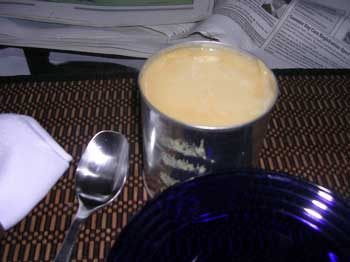
the Can, opened after cooling
When opened, the can revealed a golden nectar the consistency of honey, though creamier: a goop of thicker viscosity but with texture of melted butter. No, not quite that either.
My descriptions are feeble. But pudding this wasn’t. More like caramel ice cream topping .
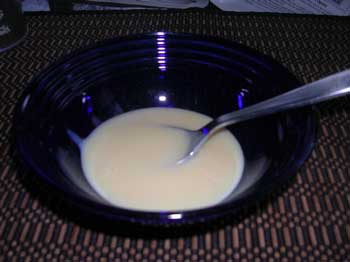
the goop in a bowl
And caramel is essentially what it tastes like. Except that caramel pales in comparison. This stuff is tremendously rich. Overwhelming to the taste buds. A very small amount will go a very long way.
I lapped-up about a quarter-cup as seen here. That was enough of the straight stuff alone.
I’ve since used it as a topping: it’s was perfect over butter-pecan ice cream. It also makes the most fantastic desert drink when added liberally to very strong coffee. I wonder how espresso would work …
Side trip to Fox’s Gap
20 April 2008
There was still plenty of daylight left as I was returning from Sharpsburg last weekend, so I took a rare detour from Alt-40 over to Fox’s Gap.
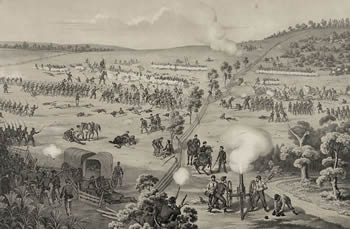
The glorious charge of the 23rd and 12th Ohio Volunteers …(1864, Library of Congress)
There are a pair of interpretive signs, two monuments, and a regimental tribute at the spot where the road crosses the Gap, noting the combat there on 14 September 1862. But that’s all there is to see as one arrives.
There was no one else there when I pulled up. It was blessedly quiet. I took a couple of snapshots to bring some of the place home with me.
Mud of our fathers
13 April 2008
Or: another great day on the battlefield.
I was glad to be part of a small group of SHAF volunteers and Park Natural Resources guys planting tree seedlings along Antietam Creek yesterday.
It was in a part of the Park I’d never visited before: a strip of low land along the west side of the stream running north from where the Burnside Bridge Road crosses about one-quarter mile above Burnside Bridge.

A new forest of green tubes (looking northeast, creek to the right)
A larger team of about 35 people had been nearby planting the weekend before, during the Park Work Day. Between us, then, we’d planted hackberry, tulip poplar, and maple (others?) three and four deep along a half-mile of creek bank. These are all native species likely to do well in that location.
These trees and the grassy field adjacent will form a riparian buffer to protect the stream and its banks. The seedlings themselves are protected and nurtured by those ‘greenhouse’ sleeves and stakes.
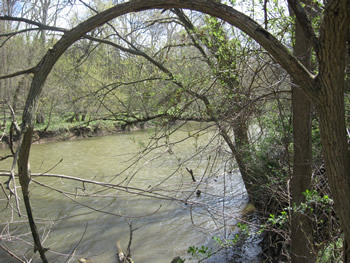
view back across Antietam Creek from west bank
On the afternoon of 17 September 1862 this ground was the province of the troops of Colonel Benjamin Christ‘s Brigade (First Brigade, First Division) of the Federal Ninth Corps.
They had crossed the stone bridge to the west bank about 2pm and followed it north to this meadow. About 3pm they formed in line of battle here preparatory to advancing toward the town of Sharpsburg [map]. In order south to north (l to r) , behind the 79th New York Infantry as skirmishers, these were the 17th Michigan, 28th Massachusetts, and Christ’s own 50th Pennsylvania regiments.
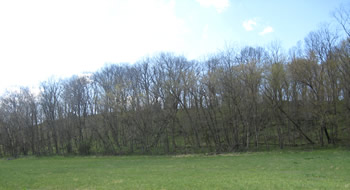
bluff west of Antietam Creek, north of bridge road
With their backs to the creek, they faced a stiff climb up that steep slope.
… after the formation of the Corps line, the Brigade advanced, under a heavy fire from Cemetery Hill and the high ground west of the road, to within a few yards of this point where it was checked. After a short delay the 79th New York advanced as skirmishers and compelled the Confederate Artillery to retire. The Brigade was about to move forward, when the attack of A.P. Hill on the left of the Corps obliged it to fall back to the Antietam …
(from War Department tablet no. 63 [map])
____________
Thanks to Tom Clemens and SHAF for sponsoring the planting, the Natural Resource Rangers for doing what they always do: take such fine care of our Park, the Chesapeake Bay Foundation (CBF) for the young trees, and to the other volunteers for getting muddy with me.
____________
For related photos–including one of Christ’s Brigade’s tablet–see a lovely page from Tom Shay created on the 100th anniversary of the raising of the monuments to 48th and 50th Pennsylvania regiments at Antietam in 2004.
Virtual blog
5 April 2008
Dang. I’ve been under a rock the last two months.
Proof?
How many blogs are there with “Antietam” in the name? Well now there are two.
Man-about-Sharpsburg Stephen Recker has begun his own in conjunction with his Virtual Antietam site.

Among his many other connections to the battle, Stephen is an infamous collector of related photographs and reunion ephemera. He’s posted a couple of pieces already, among them this ribbon from the 1891 reunion of the 130th Pennsylvania Infantry at Sharpsburg. I’m looking forward to more!
Sorry to take so long to find your new blog Stephen, and welcome to the ‘sphere. If I had known you were coming, I’d have baked a cake.
Secret no more
5 April 2008
Ranger John Hoptak reports being
finally ready, officially, to launch my effort to restore the 48th PA Monument at Antietam by replacing the sword missing from the statue of General Nagle
Get the details from the supporting A Monumental Task blog, and find your way to help this righteous project succeed, won’t you?
Happy birthday, General.

